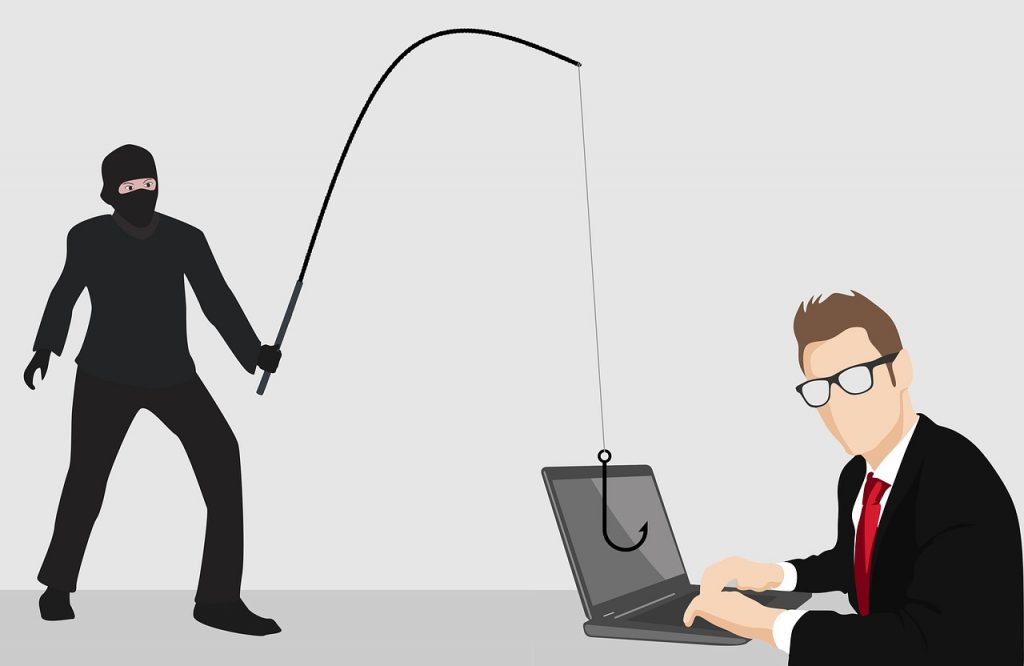 Abraham Lincoln
If given the truth, the people can be depended upon to meet any national crisis...
Abraham Lincoln
If given the truth, the people can be depended upon to meet any national crisis...
 Guildford news...
for Guildford people, brought to you by Guildford reporters - Guildford's own news service
Guildford news...
for Guildford people, brought to you by Guildford reporters - Guildford's own news service
‘Phishing’ Remains the Most Successful Method for Cyber Crooks
Published on: 5 Jun, 2021
Updated on: 7 Jun, 2021
 Cyber criminals love phishing. And when criminals go phishing, you are the fish and the bait is usually contained in a scam email or text message.
Cyber criminals love phishing. And when criminals go phishing, you are the fish and the bait is usually contained in a scam email or text message.
The criminal’s goal is to convince you to click on the links within their scam email or text message, or to give away sensitive information (such as bank details). These messages may look like the real thing but are malicious. Once clicked, you may be sent to a dodgy website which could download viruses onto your computer, or steal your passwords.
As of April 30, nearly six million emails were reported to the Suspicious Email Reporting Service (SERS). The tool, which was launched by the National Cyber Security Centre (NCSC) and the City of London Police last April, allows the public to forward suspicious emails to an automated system that scans them for malicious links. Since its launch, over 43,000 scams and 84,000 malicious websites have been removed.
 The most common phishing scams?
The most common phishing scams?
The most commonly spoofed organisation reported in phishing emails was TV Licensing, with victims of these emails alone reporting losses totalling £5.3m.
The majority of losses occurred as a result of victims following malicious links in the emails and inputting their personal information into what they thought was the legitimate TV Licensing website. Shortly after, they would receive a call from criminals impersonating bank staff who was able to convince them that their bank accounts were compromised and persuaded them to transfer all of their money to a new ‘safe’ account.
Some of the other most commonly impersonated organisations included HMRC and DVLA. We also received more than 40,000 suspicious email reports relating to Covid-19. These crooks are heartless.
Fake emails and text messages can sometimes be difficult to spot and criminals are constantly getting better at finding ways to make them seem more authentic. Email address spoofing is just one of the tactics criminals will use to try and make their fake emails look real.
Here are some tips you should follow to protect yourself, and others, from scam emails and text messages:
1: Be cautious of messages asking for your personal information. Official organisations, such as your bank, should never ask you for personal or financial information via email or text message. If you receive a message and you want to check that it’s legitimate, you can call the organisation directly using a known number, such as the one on a bank statement or utility bill.
2: Report suspicious emails. If you receive an email you’re not quite sure about, you should report it to the Suspicious Email Reporting Service (SERS) by forwarding the email to: report@phishing.gov.uk. Yo
3: Report suspicious text messages. If you receive a suspicious text message, you can report it by forwarding the message to 7726. It’s free of charge and enables your mobile network provider to investigate the origin of the text and take action, if found to be malicious.
4: Report fraud. If you’ve lost money or provided personal information as a result of a phishing scam, notify your bank immediately and report it to Action Fraud.
For more information on how to protect yourself from fraud and cyber crime, please visit: actionfraud.police.uk/
This article was based on a “Neighbourhood Alert” issued by Action Fraud.
Responses to ‘Phishing’ Remains the Most Successful Method for Cyber Crooks
Leave a Comment Cancel replyPlease see our comments policy. All comments are moderated and may take time to appear.
Recent Articles
- Guildford Institute’s Crowdfunding Project for Accessible Toilet in its New Community and Wellbeing Centre
- Letter: Guildford – Another Opportunity Missed?
- Letter: GBC’s Corporate Strategy – Where Is the Ambition?
- My Memories of John Mayall at a Ground-breaking Gig in Guildford Nearly Six Decades Ago
- Westborough HMO Plans ‘Losing the Heart of the Street’ Says Resident
- College Invests to Boost Surrey’s Economy and Close Digital Skills Gap
- Community Lottery Brings Big Wins for Local Charities
- GBC Housing Plan Promises ‘A Vibrant Urban Neighbourhood’ Near Town Centre
- Hospital Pillows ‘Shortage’ at the Royal Surrey
- Updated: Caravans Set Up Camp at Ash Manor School


Recent Comments
- Ian Macpherson on Updated: Main Guildford to Godalming Road Closed Until August 1
- Sara Tokunaga on GBC Housing Plan Promises ‘A Vibrant Urban Neighbourhood’ Near Town Centre
- Michael Courtnage on Daily Mail Online Reports Guildford Has Highest-paid Council Officer
- Alan Judge on GBC Housing Plan Promises ‘A Vibrant Urban Neighbourhood’ Near Town Centre
- John Perkins on GBC Housing Plan Promises ‘A Vibrant Urban Neighbourhood’ Near Town Centre
- S Collins on GBC Housing Plan Promises ‘A Vibrant Urban Neighbourhood’ Near Town Centre
Search in Site
Media Gallery
Dragon Interview: Local Artist Leaves Her Mark At One of England’s Most Historic Buildings
January 21, 2023 / No Comment / Read MoreDragon Interview: Lib Dem Planning Chair: ‘Current Policy Doesn’t Work for Local People’
January 19, 2023 / No Comment / Read MoreA3 Tunnel in Guildford ‘Necessary’ for New Homes, Says Guildford’s MP
January 10, 2023 / No Comment / Read More‘Madness’ for London Road Scheme to Go Ahead Against ‘Huge Opposition’, Says SCC Leader
January 6, 2023 / No Comment / Read MoreCouncillor’s Son Starts Campaign for More Consultation on North Street Plan
December 30, 2022 / No Comment / Read MoreCounty Council Climbs Down Over London Road Works – Further ‘Engagement’ Period Announced
December 14, 2022 / No Comment / Read MoreDragon Interview: GBC Reaction to the Government’s Expected Decision to Relax Housing Targets
December 7, 2022 / No Comment / Read MoreHow Can Our Town Centre Businesses Recover? Watch the Shop Front Debate
May 18, 2020 / No Comment / Read More










Bruce Penson
June 7, 2021 at 8:57 pm
The article has missed one of the most important ways to defend against such attacks. On every online account you have that allows you to, switch on multifactor (sometimes called two-factor) authentication. This will require a second code to be inputted alongside your password (generated by your phone – similar systems are in use on online banking).
This stops criminals using phishing emails to trick you into disclosing your password and giving them access to personal details, payment details, ordering from your accounts and using your email to send malicious emails.
If you don’t do this it will sadly only be a matter of time before you experience some kind of cyber breach.